Ammunition theft raises fears of increased volatility and political violence in KwaZulu-Natal.
In July 2021, around 1.2 million rounds of ammunition were looted from a shipping container in the South African port city of Durban in KwaZulu-Natal (KZN) province.1 The ammunition, worth over R3 million (US$200 000), was taken from a privately operated container yard and was not being stored in a high-security facility at the time of the theft. This is the largest known loss of ammunition in South Africa from a civilian source to date.
The theft comes at a particularly volatile time, with KZN the epicentre of the looting and violence that has followed the conviction and imprisonment of former president Jacob Zuma. The ammunition theft also adds fuel to the fire of illicit firearms in South Africa, following several scandals surrounding state regulation of firearms, and could have a serious impact on violence and crime in the province.
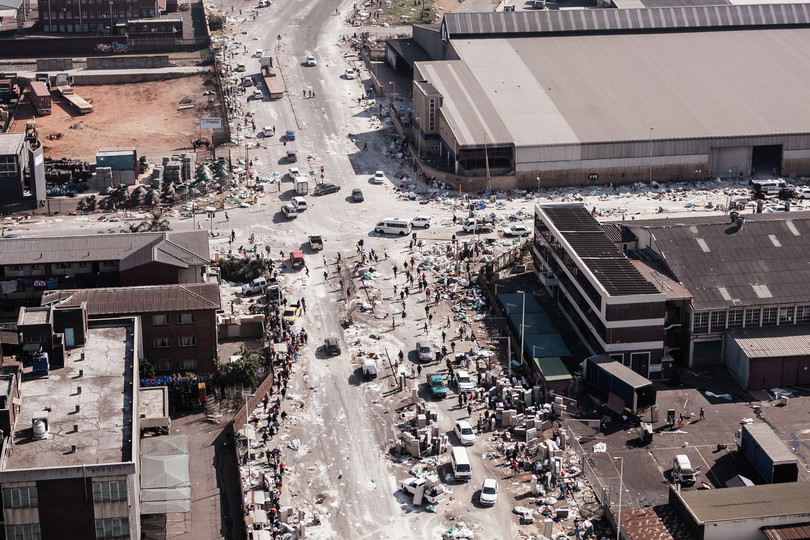
Rescue personnel at work at Springfield Park, Mobeni, south of Durban. Businesses at the park were hit by looters on 13 July 2021. Mobeni is the same area where the ammunition theft took place in the midst of looting.
Photo: Stringer/AFP via Getty Images
Ammunition in the illicit firearm economy
While illicit firearms have a long lifespan, their utility to criminal organizations is reliant on the availability of ammunition. In this they are aided by the fact that ammunition often receives least monitoring and oversight of any product in the arms sector.
Jonathan Rickell, a field investigator at Conflict Armament Research, explains that ammunition is ‘the easiest [of arms products] to divert and the most challenging to trace back to the source’.2 Countries experiencing periods of instability, he said, often saw an increase in demand for ammunition as it ‘is a single-use component and therefore an item that requires consistent re-supply to support’.
It is difficult to estimate accurately how much ammunition is lost and stolen from state and civilian sources in South Africa, as most losses go undetected. While statistics on firearms that are reported lost and stolen from police and civilians in the country are routinely released by the South African Police Service (SAPS), no such statistics are routinely released for ammunition.
However, some details have become available on state losses of ammunition from answers to questions in Parliament addressed to the ministers of defence and military veterans and of police. In August 2019, the South African police minister told Parliament that the SAPS had ‘lost’ more than 9.5 million rounds of ammunition over the past six financial years.3 Further details on how this data was collected is not publicly available. Responses to parliamentary questions also revealed several losses and thefts of ammunition from the South Africa National Defence Force since 2013, including the loss of 32 400 rounds for R4 assault rifles that were allegedly stolen from the Lenz military base south of Johannesburg in April 2013.4
Based on the (admittedly scant) available evidence, it seems that the arms theft in Durban is one of the biggest ammunition thefts in South Africa from any source, civilian or police. This theft also shines a light on the lack of public transparency about ammunition losses in South Africa.
It also outweighs seizures of ammunition made in police operations. In the 2019–2020 reporting year, the Directorate for Priority Crime Investigation (known as the Hawks), which investigates high-level organized crime in South Africa, seized 341 179 in total across all operations: less than a third of the total ammunition in the Durban shipment. Tactical response teams, which conduct operations in high-risk areas such as those affected by very high levels of gang violence involving firearms, reported 43 833 rounds of ammunition seized in this period.5
Figure 1 Breakdown of the ammunition in the Durban arms cache.
NOTE: Pistols are the most commonly used type of weapon in gang-related crimes in South Africa. Revolvers are often used in targeted assassinations because they retain their shells, allowing a quick getaway for the assassin with no shells left behind as evidence. The magazine capacity – the number of rounds that a pistol holds – can vary widely, even within firearms that take the same calibre of ammunition. The ranges were calculated based on the variety in magazine capacity for each calibre of ammunition in the cache, creating a high and low estimate. Revolvers vary between holding 5 and 7 rounds, and this range does not change regardless of the calibre of ammunition. A high and low estimate was therefore created for the revolver rounds using this range.
Was the Durban arms cache a vulnerable target for looters?
Imported from Brazil, the shipment was destined for South Africa’s administrative capital, Pretoria, 600 kilometres inland from Durban. The bulk (800 000+ rounds) of the shipment comprised 9mm rounds, the most popular form of ammunition for various brands of handguns available in the country, alongside a substantial number of 380 and 45 ACP and cartridges, which are also common ammunition for pistols. Also present were over 100 000 .38spl, 357 and 44 Magnum rounds, commonly used in revolvers.6 One firearm dealer estimated that the volume of ammunition, if sold to private handgun owners, would be sufficient to meet the needs of all such owners in South Africa for three to four months.7
The cache was imported by Formalito, a subsidiary of Outdoor Investment Holdings (OIH), the largest distributor of arms and ammunition in South Africa. OIH has been distributing firearms for more than 55 years and is responsible for about 30% of all ammunition imported into South Africa each year.8 The company said the 14-tonne shipment was intended for sale to private citizens and security forces.
According to a police source and two business people who operate in the street where the theft occurred, the yard was not under heavy guard. Security experts and activists on gun violence in KZN said the theft raises urgent questions about how the shipment came to be at that location, and who was responsible for protecting the ammunition.9
Megan Piller, the owner of Blu Logistics, which specializes in the import of firearms, ammunition and explosives into South Africa, told the GI-TOC that authorities ordinarily follow strict procedures when transporting ammunition and demand that storage facilities and transporters be registered with a ‘Class 1’ (dangerous goods) certification.10
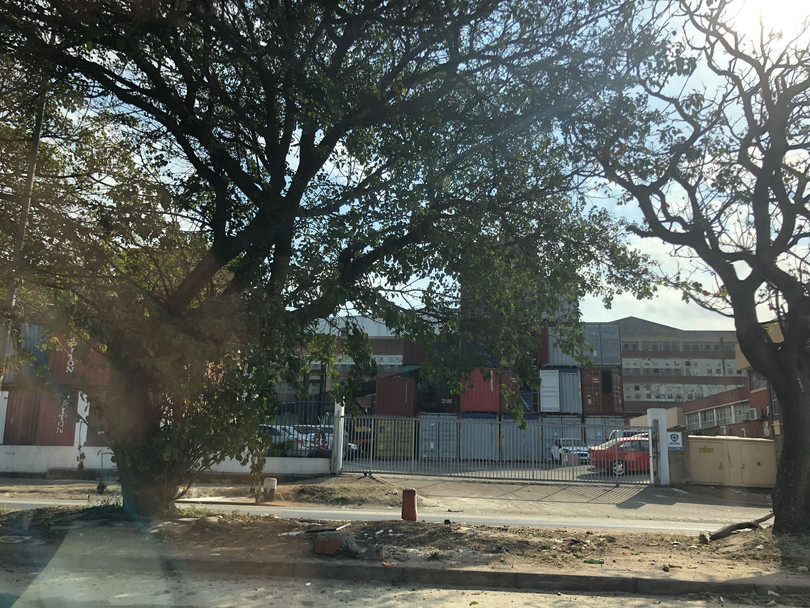
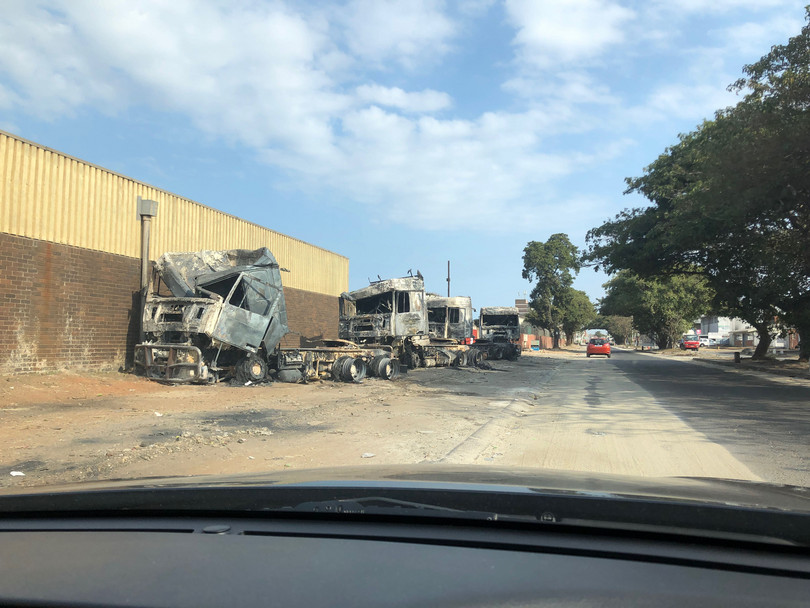
Lorries that were torched during looting (bottom) outside the Lee Trans container depot (top), where the ammunition theft took place.
Photos: Greg Arde
Specific high-security warehouses are the usual recipients of ammunitions transfers. In Gauteng, for example, such cargo would go to the Guardforce bonded warehouse, which Andrew Saulter, a firearms dealer, described as ‘like Fort Knox’.11
Piller said the movement of such goods is governed by three pieces of legislation: the Firearms Control Act or the Explosives Act; the Dangerous Goods Act; and the Customs & Excise Act.12 ‘But the laws don’t define standard operating procedures, which is incredibly frustrating because different authorities in different towns and provinces interpret these laws differently,’ she said.
Piller said normal procedure would have demanded that the container be cleared with customs one week before the vessel arrived in port. Apart from the import permit, both the shipping line and the police would have had to have the transporter’s details, the truck registration and the driver’s details on record. When the vessel docked, the fire department and the police would have to be on standby at the port. Ammunition containers get priority to be taken off the vessel first by transporters, who proceed directly to a nominated depot where the cargo is placed in secure holding until police inspect the container. Once inspected, the cargo can proceed to its destination.
The police and OIH are now at loggerheads over who was responsible for the ammunition when it was stolen. The ammunition importer, OIH, told the GI-TOC that they were satisfied that they had followed normal procedures and that, at the time the ammunition was stolen, the consignment fell under the authority and control of the clearing agents, customs and port authorities and SAPS.13 Because of the nature of the cargo, it was not permitted to remain at the port unprotected, and the company claims that an armed escort accompanied the shipment to the transport yard ahead of the inspection. (It was impossible to deliver the shipment directly to the inspection depot because it was closed due to the violence taking place.) A spokesman for the company said all documentation relating to the movement and transfer of the shipment had been forwarded to the Hawks, which is handling the investigation of the theft.14
However, police minister Bheki Cele claimed that the police were informed the ammunition had been taken from the port without their permission. A source close to the investigation also said it was unclear how the container came to be in the yard where the theft occurred.
But Andrew Whitfield, an opposition MP for the Democratic Alliance party who sits on the police portfolio committee, does not credit the idea that the police were left in the dark. In an interview with the GI-TOC, he said ‘the importer alleged that there were numerous attempts to get SAPS to inspect the shipment, so SAPS definitely knew about the shipment’. He accused authorities of being secretive about the theft or alternatively ‘clueless’.15
In addition to questions about who was responsible for the ammunition at the time of the theft, some observers have raised suspicions about whether the incident was part of the general looting taking place in Durban at the time, or whether it was premeditated. The police source close to the investigation said he believed that the theft was part of general looting rather than an organized heist. Neighbouring businesspeople attested to the fact that there was looting along most of the street and that the area was particularly badly hit, the worst hit out of several container yards in the surrounding area. They said looters ransacked several businesses and took ‘everything’, from buckets of rice to computers. The yard office was gutted by fire and a huge forklift was torched during the looting.
But there are also signs that the theft was premeditated. About 50 metres away from the site of the ammunition theft is a truck repair shop. The looters stole four rigs – eight- and 12-tonne trucks that require specialist knowledge to drive – evidence that they were well organized, according to a director of the truck-repair business. The owner of Lee Trans, the company in which the shipment was stored at the time of the theft, did not respond to questions.
In the days following the incident, several ammunition seizures were made in Mobeni, where the ammunition was looted. Police reported that several thousand rounds of ammunition thought to originate from the Durban shipment were recovered, which would still leave over 1 million rounds remaining unaccounted for.16
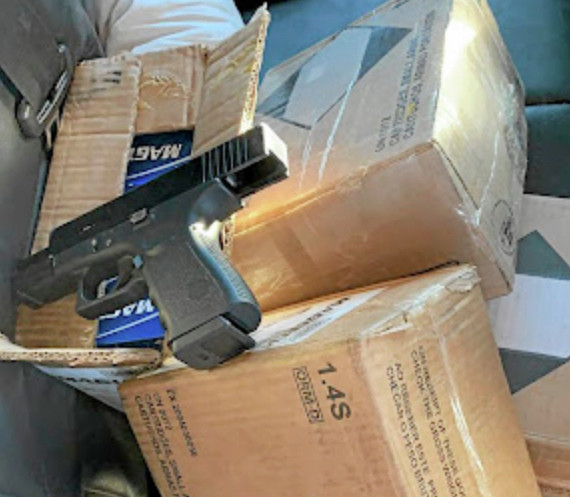
Boxes of ammunition thought to be from the Durban theft were recovered by police.
Photo: South African Police Service
Fuel to the fire of illicit firearms in South Africa
Illicit supplies of ammunition are vital for armed criminal networks, especially in South Africa, where the criminal underworld has received a huge influx of illicit firearms in recent years, with corrupt police officers taking advantage of poor management systems to channel guns to gangs. In the most prominent case of this kind, former police officer Christiaan Prinsloo, who was responsible for managing several provincial armories and firearm stores, admitted in court to being part of a network that had supplied at least 2 400 firearms to criminal groups. The investigation into Prinsloo and the network ascertained that at least 2 400 firearms had been sold to criminals in the Western Cape. They were able to link 900 of these seized firearms to 1 060 murders.17
Systemic corruption at the South African Police Central Firearm Registry has also allowed firearm licences to be granted to suspected gangsters. Digital systems designed to create an accurate and comprehensive database of firearm licensing are not fully operational, leaving the system open to manipulation. During 2020, police arrested 28 people, including high-ranking police officers and Cape Town-based underworld figures, for their involvement in the fraudulent procurement of firearm licences. Of those arrested, 17 were police officials, two were retired police officers and 11 were civilians with links to the underworld.18 In some cases, gangsters have been able to use fraudulently acquired firearms licences to buy large amounts of ammunition.
This problem is exacerbated by the fact that a lack of transparency and effective oversight mechanisms means that the scale of illicit firearms and ammunition flowing to criminal networks may be underestimated. SAPS statistics show that between 2013/2014 and 2018/2019, more than 47 028 licensed civilian firearms were reported lost or stolen, of which as many as 18 000 remain unaccounted for.19 SAPS statistics also report that 26 277 police-issue firearms were lost or stolen between 2002/2003 and 2018/2019.20
However, the true figures for lost and stolen firearms may be significantly higher. Some 20 291 civilian-owned firearms were recovered between 2003 and 2014 that had never been reported as lost or stolen by their owners.21 Changes in the way statistics for lost and stolen police firearms were recorded after 2010 also means that guns that are ‘unaccounted for’ in police stocks are not included in the statistics, but only those actively reported as lost or stolen.
In addition, many firearms under the control of other government departments may not be included in the statistics.22 For example, metropolitan police services, which fall under the control of metropolitan councils, do not have readily available data on lost and stolen firearms. One of the reasons cited for this is the fact that in these departments the loss of firearms is treated as loss of council property, rather than the loss of a lethal weapon.23
Figure 2 Armaments and ammunition in South Africa.
NOTE: The primary source of illegal guns in South Africa is civilian firearm owners, followed by the police service, whose registered, legal, firearms are lost or stolen.
SOURCE: SAPS annual report 2019–2020 financial year, and Question NW1639 to the Ministry of Police, Parliamentary Monitoring Group, 25 June 2021, https://pmg.org.za/committee-question/16759/
The impact of the ammunition theft
Guns are overwhelmingly the weapons most used in South Africa to kill, injure and intimidate. In 2018–2019, 41.3% of recorded murders and 80% of attempted murders involved a firearm. Increased access to firearms has led to more deadly gang violence. From 2010 to 2016 – the period in which Prinsloo and his network were shipping guns wholesale to Western Cape gangs – gun-related murders in the province more than doubled.24 It is into this context that the 1.2 million stolen rounds from Durban have now flowed. The calibres of ammunition in the stolen cache include those most often used in gang fights and robberies (9mm, 45 ACP) and in targeted assassinations (.38spl and Magnum rounds).
The theft also takes place in a province beset by criminal violence and targeted assassinations, particularly intra-party violence and assassinations in the ruling African National Congress. GI-TOC analysis of assassination trends has found that, between 2015 and 2020, 38% of all recorded assassinations in South Africa were in KwaZulu-Natal – the highest proportion of all provinces in South Africa. KZN recorded the highest number of hits across all different categories isolated by the GI-TOC’s analysis, including assassinations linked to the taxi industry, assassinations in personal feuds, assassinations linked to organized crime and political assassinations.25
The rate of political assassinations in KZN between 2015 and 2020 was almost five times that of the next-highest scoring province, Gauteng.26 Previous GI-TOC analysis of political assassinations in the province found that violence spikes particularly around election time. In the wake of violence and looting that has centred in the province in the aftermath of Zuma’s imprisonment – which has claimed the lives of over 330 people nationwide, the majority in KZN27 – there are concerns of a spike in violence in the upcoming local government elections in September 2021.
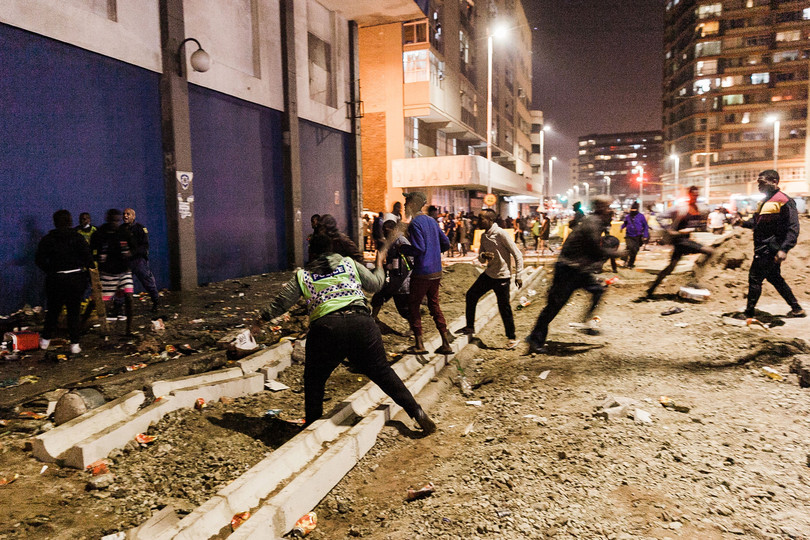
South Africa Police Service officers respond to looting in central Durban, 11 July 2021.
Photo: AFP via Getty Images
Questions for future investigations
There are a lot of questions about this ammunition theft that any investigation or inquiry would have to answer. Whose responsibility the consignment was at the time of the theft is clearly an issue of contention between the police and the importer. Why the consignment was not in a higher security facility, how as much as 14 tonnes of ammunition was able to be taken away, and whether the targeting of this container yard was deliberate also remain open. However, while the scale of this theft was extraordinary, it was also only the latest in a series of extraordinary episodes in South African firearms control that has empowered criminal groups and made criminal violence in South Africa more deadly.
Notes
-
Ammunition stolen during Durban looting could be in criminals’ hands: ISS, SABC News, 22 July 2021, https://www.sabcnews.com/sabcnews/ammunition-stolen-during-durban-looting-could-be-in-criminals-hands-iss/. ↩
-
Interview, Jonathan Rickell, field investigator at Conflict Armament Research, July 2021. ↩
-
Getrude Makhafola, More than 4 000 police service guns lost in past six years, African News Agency/ANA, https://www.iol.co.za/news/politics/more-than-4-000-policeservice-guns-lost-in-past-six-years-ffplus-30700113. ↩
-
SANDF ammunition and weapons stolen and lost, DefenceWeb, 16 October 2015, https://www.defenceweb.co.za/sa-defence/sa-defence-sa-defence/sandf-ammunition-and-weapons-stolen-and-lost/; Guy Martin, SANDF weapons used in transit heist, DefenceWeb, 21 June 2018, https://www.defenceweb.co.za/sa-defence/sa-defence-sa-defence/sandf-weapons-used-in-cash-in-transit-heists/; Theft and loss of SANDF weapons and ammunition worrying, DefenceWeb, 5 April 2019, https://www.defenceweb.co.za/featured/theft-and-loss-of-sandf-weapons-and-ammunition-worrying/. ↩
-
South African Police Service, Annual Report 2019/20, https://www.gov.za/sites/default/files/gcis_document/202012/south-african-police-service-annual-report-20192020.pdf. ↩
-
Inventory stock list on file with the GI-TOC. ↩
-
In South Africa, a firearm owner may not purchase more than 200 rounds of ammunition at any one time. Interview with Andrew Saulter, firearm dealer, Interview conducted by phone, 23 July 2021. ↩
-
Interview with Andrew Saulter, firearm dealer, by phone, 23 July 2021. ↩
-
Interviews with security experts Mary de Haas and Ryan Cummings, July 2021. ↩
-
Interview with logistics expert Megan Piller, by phone, July 2021. ↩
-
Interview with Andrew Saulter, firearm dealer, by phone, 23 July 2021. ↩
-
Interview with logistics expert Megan Piller, by phone, July 2021. ↩
-
Interview with Johannes Coertze, by phone, 27 July 2021. ↩
-
Interview with Johannes Coertze, by phone, 27 July 2021. ↩
-
Interview with Andrew Whitfield, by phone, 20 July 2021. ↩
-
See: South African Government, Acting Minister Khumbudzo Ntshavheni: Update on security situation prevailing in the country, 16 July 2021, https://www.gov.za/speeches/acting-minister-khumbudzo-ntshavheni-update-security-situation-prevailing-country-16-july. During a visit to KZN on 23 July 2021 the Minister of Police Bheki Cele told the media that that 10 000 rounds of ammunition, thought to have originated from the container, had been seized by police in the province. Greg Arde and Jeff Wicks, #UnrestSA: Thousands of looted bullets spread across KwaZulu-Natal, News24, 19 July 2021, https://www.news24.com/news24/southafrica/news/unrestsa-thousands-of-looted-bullets-spread-across-kwazulu-natal-20210719. Collectively, these seizures would mean that the police have only recovered a total of 16 000 rounds leaving well over 1.18 million rounds unaccounted for. In Phoenix outside Durban, 22 people were arrested and police seized 152 firearms from private security companies operating in the area and another 112 illegal firearms from residents in the area. Ammunition was seized during these operations though no link has been firmly established to the stolen ammunition. Local media have reported that a Durban man, the son of a prominent pastor, was charged with possession of unlicensed ammunition that may have originated from the stolen cache. He has denied the allegations. Orrin Singh, Phoenix link probed in ammo looting, Sunday Times, 1 August 2021, https://www.pressreader.com/south-africa/sunday-times-1107/20210801/281732682527127. ↩
-
Madelyn Winchester, Illegal guns leading to rise in murders in the Western Cape, Cape Argus, 7 August 2019, https://www.iol.co.za/capeargus/news/illegal-guns-leading-to-rise-in-murders-in-the-western-cape-30443334. ↩
-
Jenni Irish-Qhobosheane, How to silence the guns?: Southern Africa’s illegal firearms markets, Global Initiative Against Transnational Organized Crime, forthcoming. ↩
-
Figures taken from SAPS annual reports, 2013/14 to 2018/19, https://www.saps.gov.za/about/stratframework/annualreports.php. ↩
-
Figures taken from SAPS annual reports, 2013/14 to 2018/19, https://www.saps.gov.za/about/stratframework/annualreports.php. ↩
-
Analysis of the Firearms Control Act on crime, 1999–2014, commissioned by the Civilian Secretariat for Police December, Wits School of Governance (unpublished), 2015. ↩
-
Jenni Irish-Qhobosheane, How to Silence The Guns?: Southern Africa’s illegal firearms markets, Global Initiative Against Transnational Organized Crime, forthcoming. ↩
-
Andrew Faull, Bring them into line: Managing corruption in SAPS and metro police departments, SA Crime Quarterly, 23, March 2008. ↩
-
Gun Free South Africa, Firearms Control Briefing 2 of 2019: Western Cape mortuary surveillance shows gun deaths doubled in 6 years, 5 March 2019, www.gfsa.org.za. ↩
-
Kim Thomas, Murder by contract: Targeted killings in eastern and southern Africa, Global Initiative Against Transnational Organized Crime, forthcoming. ↩
-
Ibid. ↩
-
Rebecca Davis, Greg Nicolson and Bheki Simelane, South Africa’s three bloodiest days: 342 dead and we are still in the dark, Daily Maverick, 8 August 2021, https://www.dailymaverick.co.za/article/2021-08-08-south-africas-three-bloodiest-days-342-dead-and-we-are-still-in-the-dark/. ↩
